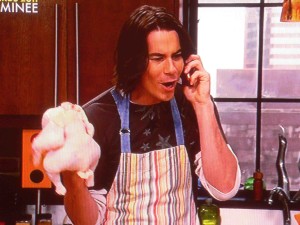We were having dinner with friends Sunday night, and they do a Chinese-style cooking that is light and yummy, but I noticed a lot of cross-contamination going on during the prep (can someone please come up with a better name than cross-contaminaion, and more succinct than, dangerous bugs move around a lot).
 The patron said, that’s why you cook it, and I said, just cook it doesn’t cut it, and explained why.
The patron said, that’s why you cook it, and I said, just cook it doesn’t cut it, and explained why.
We may never be invited for dinner again.
The next day (another school holiday) the two 5-years-olds were with me for a few hours, so after a couple of hours at the park, I decided we would make two cakes — one gluten/dairy free, one traditional.
I don’t like cake but it is a part of my spring ritual of getting rid of spices that have accumulated for six years and, like Ikea furniture, crap that looked good at the store but awful at home.
The girls became involved in an extended discussion of Salmonella, eggs and cross-contamination.
They enjoyed the cake.
Brown et al. published in Applied and Environmental Microbiology that the bacterial pathogen Campylobacter jejuni is primarily transmitted via the consumption of contaminated foodstuffs, especially poultry meat. In food processing environments, C. jejuni is required to survive a multitude of stresses and requires the use of specific survival mechanisms, such as biofilms. An initial step in biofilm formation is bacterial attachment to a surface.
Here, we investigated the effects of a chicken meat exudate (chicken juice) on C. jejuni surface attachment and biofilm formation. Supplementation of brucella broth with ≥5% chicken juice resulted in increased biofilm formation on glass, polystyrene, and stainless steel surfaces with four C. jejuni isolates and one C. coli isolate in both microaerobic and aerobic conditions. When incubated with chicken juice, C. jejuni was both able to grow and form biofilms in static cultures in aerobic conditions. Electron microscopy showed that C. jejuni cells were associated with chicken juice particulates attached to the abiotic surface rather than the surface itself.
 This suggests that chicken juice contributes to C. jejuni biofilm formation by covering and conditioning the abiotic surface and is a source of nutrients. Chicken juice was able to complement the reduction in biofilm formation of an aflagellated mutant of C. jejuni, indicating that chicken juice may support food chain transmission of isolates with lowered motility. We provide here a useful model for studying the interaction of C. jejuni biofilms in food chain-relevant conditions and also show a possible mechanism for C. jejuni cell attachment and biofilm initiation on abiotic surfaces within the food chain.
This suggests that chicken juice contributes to C. jejuni biofilm formation by covering and conditioning the abiotic surface and is a source of nutrients. Chicken juice was able to complement the reduction in biofilm formation of an aflagellated mutant of C. jejuni, indicating that chicken juice may support food chain transmission of isolates with lowered motility. We provide here a useful model for studying the interaction of C. jejuni biofilms in food chain-relevant conditions and also show a possible mechanism for C. jejuni cell attachment and biofilm initiation on abiotic surfaces within the food chain.
Helen L. Brown, Mark Reuter, Louise J. Salt, Kathryn L. Cross, Roy P. Betts, and Arnoud H. M. van Vliet
http://aem.asm.org/content/80/22/7053.abstract?etocjejuni
